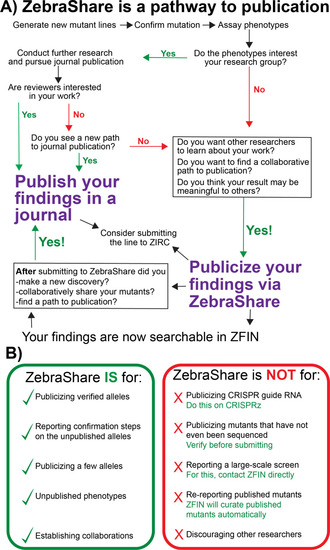- Title
-
ZebraShare: a new venue for rapid dissemination of zebrafish mutant data
- Authors
- DeLaurier, A., Howe, D.G., Ruzicka, L., Carte, A.N., Mishoe Hernandez, L., Wiggins, K.J., Gallati, M.M., Vanpelt, K., Loyo Rosado, F., Pugh, K.G., Shabdue, C.J., Jihad, K., Thyme, S.B., Talbot, J.C.
- Source
- Full text @ Peer J.
|
Publicizing a mutant on ZebraShare in 5 steps. |
|
(A) Align the WT and mutant sequence. (B) Blast the aligned WT sequence and determine the base numbers altered in the mutant. (C) Transfer these coordinates to the ZebraShare submission workbook. Descriptions become more complex for combined insertion/deletions alleles (InDels) and for alleles with multiple mutation sites due to use of multiple guide RNAs. |
|
(A) The allele description page shows information that helps researchers interpret the mutant. (B) The abstract page gives an overview of phenotypic characterization. (C) The figure associated with the abstract shows pertinent phenotypic details. For |
|
Wild-type larvae (A–C) compared with |
|
(A, B) Frames from time-lapse imaging ( |
|
(A) Normal sibling and (B) snu13a;snu13b double mutant at 24 hpf. Tail region is outlined in orange, head in blue. The shown double mutant was confirmed to be homozygous by Sanger sequencing. Scale bar is 1 mm. |
|
(A) A ZebraShare submission immediately disseminates your information to the scientific community and also can serve as a pathway to journal publication. (B) Comparison of correct and misplaced ZebraShare submissions, with solutions for incorrect uses. |







